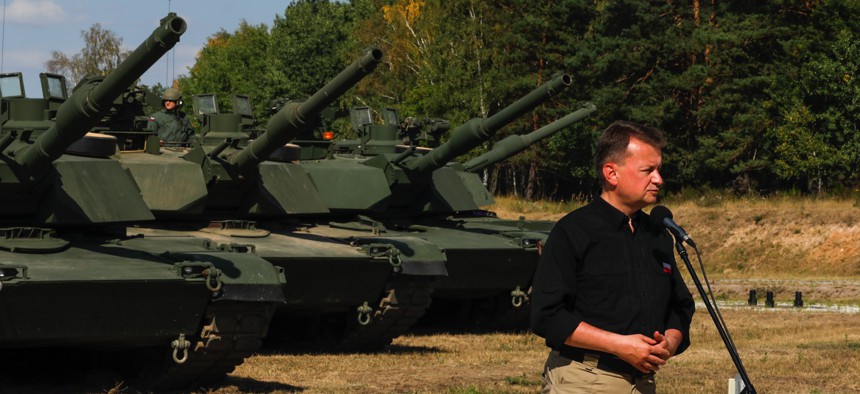
Polish Defense Minister Mariusz Błaszczak gives a speech during the opening ceremony of the Abrams Tank Training Academy at Biedrusko, Poland, Aug. 10, 2022. U.S. Army National Guard / Spc. Hassani Ribera
US Army Readies Ukraine Abrams Tank Options For Policymakers
Logistical details must be hashed out in the wake of Biden’s pledge.
Now that the White House has pledged to send M1 Abrams tanks to Ukraine, the Army is working up various plans to help the Ukrainian military operate the maintenance-hungry and fuel-thirsty battlefield behemoths.
“The Army is developing options that will be presented to senior leaders,” Douglas Bush, the Army’s top acquisition official, said at a Pentagon briefing just hours after President Joe Biden announced the coming transfer of 31 tanks to Ukraine. “I think there are multiple courses of action and it's not just the tanks. We have to be able to deliver the tanks, the support equipment, the training, the ammunition, the fuel, you know, the total package fielding like we do with other Abrams partners.”
Bush, a West Point graduate who was an Army armor officer, said the Abrams “has a significant logistics aspect to it.” Typically, the U.S. provides training and other related equipment with foreign arms deals so that the weapon remains effective.
“I assume that that will be part of what's provided,” he said.
Bush said that policymakers will decide the timeline for sending the tanks to Ukraine and that “the Army will make whatever they want to happen, happen.”
The U.S. has not built new Abrams tanks since the early 1990s. With the Cold War over, thousands of Abrams that were built to fight the Soviet Union were put into storage, according to Dean Lockwood, a military vehicle analyst with Forecast International.
These days, defense contractor General Dynamics remanufactures Abrams tank hulls for the U.S. Army and allies in Lima, Ohio. The overhauls produce “essentially a spanking brand-new tank for about half price,” Lockwood said.
Currently, the U.S. has about 8,000 Abrams, but “significantly less” are battle-ready, he said. The U.S. draws from those tanks in storage and remanufactures them for allies, such as Poland, which is buying upwards of 350 Abrams.
General Dynamics executives said Wednesday that the Abrams production line can meet the demand of sending tanks to Ukraine.
“Staffing is not an issue here. There is plenty of capacity on the combat vehicle side [of the company] both tracked and wheeled [vehicles],” CEO Phebe Novakovic said on the company’s quarterly earnings call. “So to the extent that the U.S. government intends to execute any contracts with respect to some of these bilateral agreements they are developing...it's well within the capacity of the industrial base to accommodate.”
The transfer of U.S. and European main battle tanks to Ukraine marks a shift in the types of weapons transferred by the United States and its allies from standoff defensive weapons to an offensive system on the front lines.
“A tank, by definition, has to be at the very front,” he said.
The U.S. will likely remove classified electronics from the Abrams before shipping them to Ukraine, similar to what it did with a Stinger missile part last year. Yet Lockwood noted that even a somewhat stripped-down Abrams, if captured by Russian forces, could help Moscow look for vulnerabilities or reverse-engineer NATO technology.
“I suspect there are a lot of people in the Army who are not happy about this whatsoever,” he said.
The Abrams and Challenger tanks proved far more lethal than Soviet-designed tanks during the 1991 Gulf War, Lockwood said.
“You had Abrams and Challengers that could hit and defeat a Russian tank beyond the maximum range of the Russian tank’s main gun,” he said. “In close combat they could just maneuver faster.”
The tanks used by Russia today are “basically updated versions of those same tanks,” Lockwood said.
In that light, the Abrams decision itself serves as a strong physiological weapon toward Russian commanders who know its lethality.
NEXT STORY: US to Send 31 M1 Abrams Tanks to Ukraine
